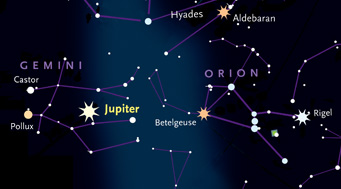Every January millions resolve to do something, anything, different or better in the coming year. So why not try to do more skygazing during 2014?
As soon as the Sun sets, you'll see a dazzlingly bright “star” parked just above the southwestern horizon. That's actually the planet Venus, our closest planetary neighbor. Venus is wrapping up a long, wonderful showing in the evening sky.

Brilliant Jupiter finds itself situated among several bright stars during January 2014.
Sky & Telescope diagram
Turn around, and you'll see Jupiter shining brightly above the northeastern horizon. It’s called the king of planets for a reason — it's big, it's bright, and it’ll dominate the evening sky for the next several months.
Another obvious asterism is the five-star zigzag of Cassiopeia. It looks like a flattened M in winter. Step outside, face north, and look almost straight up. It's a little wider than your fist at arm's length. In spring and summer, when the Big Dipper rides high, Cassiopeia lurks low. In fall and winter, it’s Cassiopeia’s turn to shine high over the evening world, while the Dipper sinks low behind the trees.
To get more skywatching tips, download this month's 7½-minute-long audio audio sky tour.
 0
0
Comments
You must be logged in to post a comment.